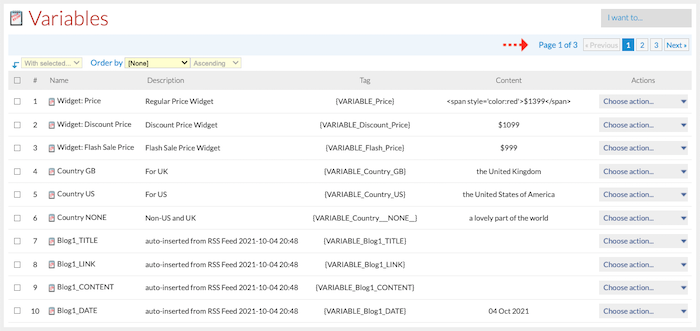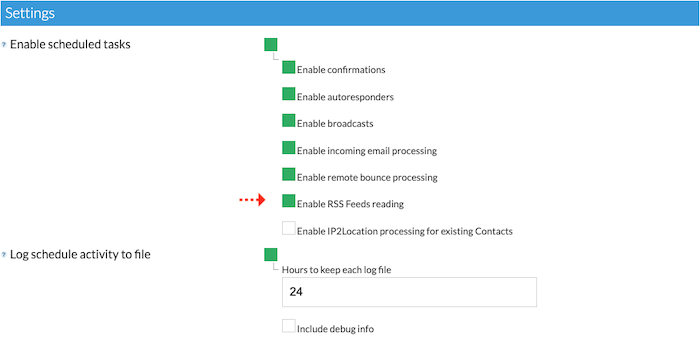The RSS to Email feature gives you the ability to use RSS Feeds within your emails and drive your readers back to the source of information, which is usually your blog. You can use this feature in lots of creative ways as part of your marketing automation strategy.
#V2 allows you to connect to and read an RSS Feed into variables, which you can then use to insert to your follow-up and broadcast messages.
To connect an RSS Feed, go to Content / Variables / List RSS Feeds:

… and choose Connect new RSS feed from the I want to… drop-down menu:

To edit an RSS Feed, choose Edit from the Choose action… drop-down menu.

When adding or editing an RSS Feed, the settings are the same.

- Variable Prefix – enter a unique prefix for variables to be populated from RSS Feed. V2 will generate a set of variables for each RSS Feed numbered from 1 for the very newest post and up to the max number of posts to read (e.g., Blog1_TITLE, Blog1_LINK, Blog1_DATE, Blog1_CONTENT, Blog1_ENCLOSURE for the newest post and Blog2_TITLE, Blog2_LINK, Blog2_DATE, Blog2_CONTENT, Blog2_ENCLOSURE for the previous post).
Use variable tags to insert their content into messages. For example:New post "{VARIABLE_Blog1_TITLE}" at {VARIABLE_Blog1_DATE} was published <a href="{VARIABLE_Blog1_LINK}">HERE</a>. Read it now: {VARIABLE_Blog1_CONTENT}
- RSS Name – enter a unique name for the RSS Feed.
- RSS URL – enter the URL of the RSS Feed.
- Max number of posts to read – enter the max number of posts to read from the RSS Feed. This limits the number of variables to be generated. When an RSS Feed contains fewer posts, variables would be generated for existing posts only.
- Fetch Feed Interval (hours) – enter the interval (in hours) to fetch the RSS Feed and renew the variables.
Once you have added/connected your RSS Feed, you will see the first and last variables that you can use.

The RSS Feed variables that are also available for you to use will also be listed on the Variables list screen (Content / Variables / Show List).

The RSS Feed variables will appear after any existing variables in the list. Depending on how many variables you have available, you may need to use the list paging buttons (see image above) to go to the next page.
Tip! Create a looping autoresponder message which gets sent to your contacts once per week. In the message, you could include the RSS Feed variable tags/shortcodes for your latest blog posts. Providing you update your blog with a new post at least once a week, your readers will get fresh content delivered by email with a link to read the full blog post on your blog.
RSS Feeds are read during the run of the #V2 script (cron job) as scheduled (based on the Fetch Feed Interval settings). You can enable/disable the RSS Feeds reading task in Setup / System Settings / Scheduled Tasks / Settings / Enable schedule tasks.

